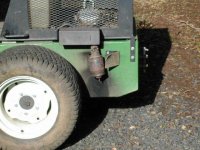Gravy
Platinum Member
George,
It wouldn't pump even with the engine running. I suspect the oil prevented the diaphragm from moving properly. It probably would work now that it's cleaned out, but I expect it would eventually fill up again. I feel more comfortable with the electric pump, but will keep the OE in place in case the electric pump dies at an inopportune time.
I used a standard Bosch 5-pin relay to power the pump, using the oil cooler fan power wire to operate the relay coil, and connected the contacts direcly to the battery (with a fuse, of course).
I agree about OE limitations. I kind of doubt that the engineers at Robin expected the engine to be operated at the angles a PT can routinely handle. I believe the lubrication system is rated to 20 or 25 degrees of slope, but they probably didn't test the fuel pump for hours at those angles. It probably works just fine at the angles a conventional tractor can handle.
One other thing I did while making changes to the fuel system was to add a shutoff valve to the tank outlet. I don't like gravity-feed systems that can't be readily shut off in case of a hose leak. You can spill a lot of fuel while you run around looking for a plug.
The QA cylinder leak appears to have been due to the shaft seal coming adrift from it's seat inside the cylinder. When I removed the end cap, the seal ring was moving with the shaft, not staying in the cap. I cleaned and inspected everything under magnification, and saw no damage or any indication of why it came loose /forums/images/graemlins/confused.gif, so I reseated the seal and reassembled. I've operated it several dozen times so far with no leakage, but I'll be watching it closely for a while.
Gravy
It wouldn't pump even with the engine running. I suspect the oil prevented the diaphragm from moving properly. It probably would work now that it's cleaned out, but I expect it would eventually fill up again. I feel more comfortable with the electric pump, but will keep the OE in place in case the electric pump dies at an inopportune time.
I used a standard Bosch 5-pin relay to power the pump, using the oil cooler fan power wire to operate the relay coil, and connected the contacts direcly to the battery (with a fuse, of course).
I agree about OE limitations. I kind of doubt that the engineers at Robin expected the engine to be operated at the angles a PT can routinely handle. I believe the lubrication system is rated to 20 or 25 degrees of slope, but they probably didn't test the fuel pump for hours at those angles. It probably works just fine at the angles a conventional tractor can handle.
One other thing I did while making changes to the fuel system was to add a shutoff valve to the tank outlet. I don't like gravity-feed systems that can't be readily shut off in case of a hose leak. You can spill a lot of fuel while you run around looking for a plug.
The QA cylinder leak appears to have been due to the shaft seal coming adrift from it's seat inside the cylinder. When I removed the end cap, the seal ring was moving with the shaft, not staying in the cap. I cleaned and inspected everything under magnification, and saw no damage or any indication of why it came loose /forums/images/graemlins/confused.gif, so I reseated the seal and reassembled. I've operated it several dozen times so far with no leakage, but I'll be watching it closely for a while.
Gravy

